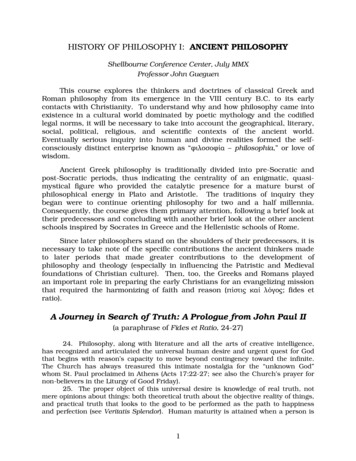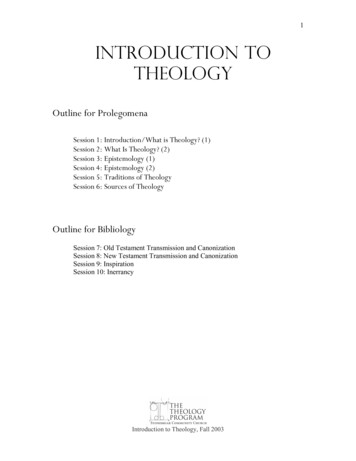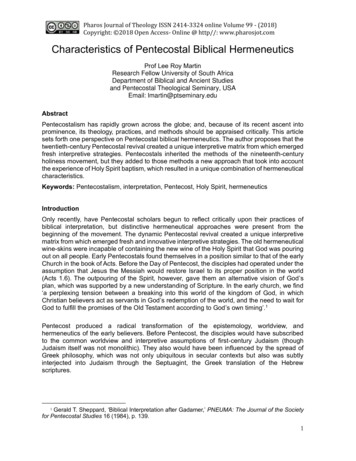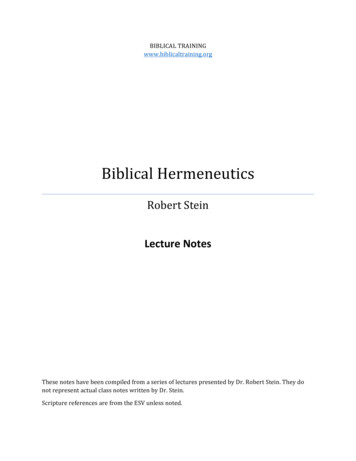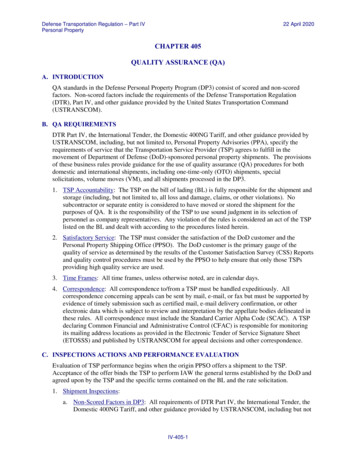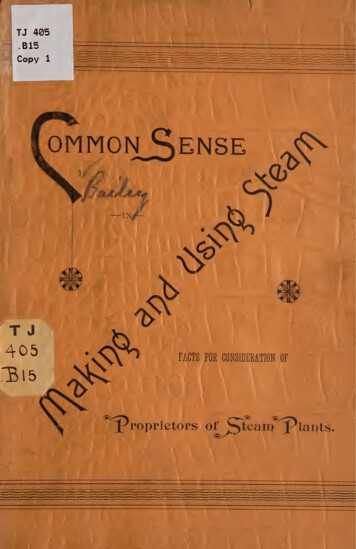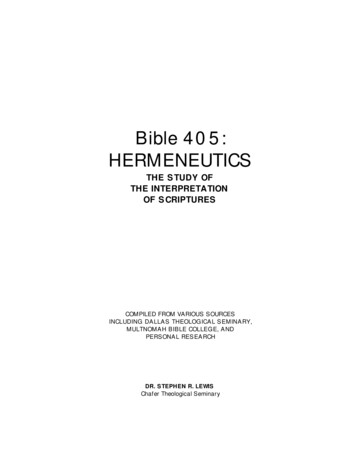
Transcription
Bible 405:HERMENEUTICSTHE STUDY OFTHE INTERPRETATIONOF SCRIPTURESCOMPILED FROM VARIOUS SOURCESINCLUDING DALLAS THEOLOGICAL SEMINARY,MULTNOMAH BIBLE COLLEGE, ANDPERSONAL RESEARCHDR. STEPHEN R. LEWISChafer Theological Seminary
Chafer Theological SeminaryHermeneuticsDr. Stephen R. LewisInstructorINTERPRETATION"Bridging the Gaps"CLASS CALENDARINTRODUCTION TO HERMENEUTICSWEEK 1Hermeneutics? What's That? (Challenges, Definitions, Problems, Results) andWhose View Is Valid? (Axioms and Maxims, or The Principal Principles)Class Notes:Lockhart's Axioms of HermeneuticsGreek words for HermeneuticsDefinitions of Hermeneutics and Related TermsReading:Zuck, Rightly Divided: Readings in Biblical Hermeneutics, pp. 1-81Zuck, Basic Bible Interpretation, pp. 9-26, 59-75Project:Suppose a friend of yours, a new believer, whom you recently led to the Lord, haswritten to you about the Bible. He/she writes, "I'm reading the Bible as yousuggested I do, but frankly I'm having difficulty understanding it. I talk to oneperson about problems in a passage I read, and he explains them one way. I talk toanother person and he explains them differently. And they both claim to be taught bythe Holy Spirit. How can I know which views are correct?"Write a letter (of 250-500 words) answering his/her questions. Be sure to speak tothese issues: basic principles of interpretation, the place of the Holy Spirit ininterpretation, and qualifications of a Bible interpreter.UNIT ONE: THE HISTORICAL WORLD OF BIBLE INTERPRETATIONWEEK 2How Did We Get Here? (Hermeneutics then and now)Class Notes: Highlights in the History of HermeneuticAncient Jewish ExegesisGreek and Jewish AllegorgateEarly Church FathersApologistsAlexandrian and Antiochene FathersLate Church FathersMiddle ages (590-1517)The ReformationPost Reformation (1550-1800)Modern era (1800-present)Reading:Zuck, Basic Bible Interpretation, pp. 27-58Project:Report first 75 pages of collateral reading from approved list2
Chafer Theological SeminaryHermeneuticsDr. Stephen R. LewisInstructorUNIT TWO: THE WORLD BEHIND THE TEXTWEEK 3What is Literal, Historical (Cultural), Grammatical, Rhetorical InterpretationClass Notes: Where's the Author Coming From? (Bridging the Cultural Gap) Hermeneutics andthe Historical-Cultural ContextReading:Zuck, Rightly Divided: Readings in Biblical Hermeneutics, pp. 245-257Zuck, Basic Bible Interpretation, pp. 76-97Projects:Do the Exercise on pages 91-92 in Zuck, Basic . . .Write a paper (of 250-500 words) on this question: Was Jesus' practice offootwashing a "cultural" custom only for His time, or is it "trans-cultural" and to bepracticed today? Why or why not? How do we know which commands in the Biblewere culture-bound and which ones are trans-cultural?WEEK 4What Does the Text mean by That? (Bridging the Grammatical Gap)Class Notes: Hermeneutics and the Grammatical InterpretationReading:Zuck, Rightly Divided: Readings in Biblical Hermeneutics, pp. 85-101,133-182Zuck, Basic Bible Interpretation, pp. 98-122Project:Do the Exercise on pages 119-120 in Zuck, Basic . . .UNIT THREE: THE WORLD IN THE TEXTWEEK 5What Kind of Book Is It? (Bridging the Rhetorical Gap)Class Notes: Hermeneutics and the Rhetorical InterpretationReading:Zuck, Rightly Divided: Readings in Biblical Hermeneutics, pp. 85-101,133-182Zuck, Basic Bible Interpretation, pp. 123-142Project:Report second 75 pages of collateral reading from approved listWEEK 6Why is it laid out that way?Class Notes: Structure AnalysisMid-Term ExamWEEK 7Why Did He Say It That Way? (Figuring out Figurative Language)Class Notes: Figures of SpeechReading:Zuck, Rightly Divided: Readings in Biblical Hermeneutics, pp. 102-142Zuck, Basic Bible Interpretation, pp. 143-168Project:Do the Exercises on pages 163 & 168 in Zuck, Basic . . .3
Chafer Theological SeminaryHermeneuticsWEEK 8Dr. Stephen R. LewisInstructorWhen Is a Type a Type? (Testing the Types and Sensing the Symbols)Class Notes: TypologySymbolsReading:Zuck, Basic Bible Interpretation, pp. 169-193Project:Write a paper 500-1000 words answering the following questions (due at end ofweek 9):Is “tupos” a technical term in scripture? By a narrow definition, some of the uses ofthe word may be non-technical. How do we know that it is a technical term at all?The opposing idea would be that it just means “pattern,” and that nothingdistinguishes it from “skia” (shadow) and other similar words. (see Louw & Nida,domain 58.i and 58.j, for example). In this case, could Scripture use a word otherthan “tupos” to designate a type.Is typology, even narrowly defined as Caird or Zuck would have it, a legitimate fieldof inquiry at all? What biblical basis do we have for establishing such a category?WEEK 9Psalms (Poetry), Parables, Allegories & O.T. Apocalyptic LiteratureClass Notes: Psalms (Poetry), Parables, Allegories & O.T. Apocalyptic LiteratureReading:Zuck, Basic Bible Interpretation, pp. 194-226Project:Report third 75 pages of collateral reading from approved listPaper concerning typology due at end of this weekWEEK 10Narratives & Prophetic LiteratureClass NotesNarratives: Allegorizing or Principlizing? & Prophecy: Bugaboo or Blessing?(Penetrating the Prophetic "Sound Barrier")Reading:Zuck, Basic Bible Interpretation, pp. 227-249Project:Analyze two sermons you have heard where someone used Narrative portions of theOT or NT and determine if the speaker “principlized” or “allegorized” the passage inapplying the people and/or circumstances to the congregation.WEEK 11Why Quote the Old Testament Like That? (Using the Old in the New)Class Notes: Use of O.T. in N.T.Reading:Zuck, Rightly Divided: Readings in Biblical Hermeneutics, pp. 183-230Zuck, Basic Bible Interpretation, pp. 250-278Project:Do the Exercise on page 270 in Zuck, Basic . . .4
Chafer Theological SeminaryHermeneuticsDr. Stephen R. LewisInstructorUNIT FOUR: THE WORLD IN FRONT OF TEXTWEEKS12 & 13How Does the Bible Apply to Today? (Bridging the Time Gap)Class Notes: ApplicationReading:Zuck, Rightly Divided: Readings in Biblical Hermeneutics, pp. 258-296Zuck, Basic Bible Interpretation, pp. 279-292Project:By end of Week 13 read the Book of Jude and list as many interpretive questions asyou can, going through the book verse by verse. The more, the better. "Bombard"the text with all kinds of questions (pertaining to meaning not the application of thetext). Try to list from Jude several questions in each of the categories of:backgrounds (historical/cultural), terms (grammatical/syntactical), structures, andforms (genre/rhetorical).Keep in mind these statements: "The interpretative question is in reality theintermediate step between observation and interpretation." (Traina,Methodical Bible Study, p. 97.) ". . . the key to interpretation ofScripture lies in the kind of questions that are put to it. The right questionsprovide the right combination to unlock the treasure." (Paul Helm, "Historyand Biblical Interpretation," The Banner of Truth, March 1973, p. 28.)WEEK 14Class Notes:Project:Overall Evaluation SummaryCreative Use of ParaphraseSynthetic Bible StudyProcess of Developing Biblical TheologySermon StructureReport last 75 pages of collateral reading from approved list5
Chafer Theological SeminaryHermeneuticsDr. Stephen R. LewisInstructorAIMS FOR THIS COURSE IN HERMENEUTICSGENERAL AIMSTo provide a method for the understanding the Word of GodTo produce doers of the WordTo spread the truth of God's Word through capable expositorsSPECIFIC AIMSTo know basic facts pertaining to the history, principles,and practice of hermeneutics.To gain insight into issues in both general and special hermeneutics.To appreciate the significance of a proper hermeneutical approachto the Bible and to develop a lifelong attitudeof excitement toward hermeneutics.To gain skill in appropriating principles of hermeneuticsto various kinds of biblical passages.6
Chafer Theological SeminaryHermeneuticsDr. Stephen R. LewisInstructorREQUIREMENTS FOR THIS COURSE IN HERMENEUTICSREADING1.Read the course textbooks, Basic Bible Interpretation by Roy B. Zuck, and RightlyDivided: Readings in Biblical Hermeneutics edited by Roy b. Zuck according tothe schedule in the Class Calendar. Fulfillment of this requirement will be demonstrated bysuccessfully completing projects from assigned readings. (10 % of class grade)2.For collateral reading, choose 300 pages from one or more of the following (or a bookapproved by the instructor): (20 % of class grade)The Hermeneutical Spiral by Grant OsborneHas the Church Misread the Bible? by Moises SilvaMultipurpose Tools For Bible Study by Frederick DankerFoundations for Biblical Interpretation edited by D. Dockery, K. Mathews & R.SloanBiblical Interpretation: An Integrated Approach by W. Randolph TateProtestant Biblical Interpretation by Bernard RammExpository Hermeneutics by Elliott JohnsonMethodical Bible Study by Robert TrainaInterpreting the Word of God by Samuel Schultz and Morris InchThe Literature of the Bible by Leland RykenValidity in Interpretation by E.D. HirschHow to Read A Book by Mortimer Adler and Charles Van DorenHermeneutics: Principles and Processes of Biblical Interpretation by Henry A.VirklerThe fulfillment of this requirement (Due by end of Sessions as listed in the class calendar)will be demonstrated by a reading report consisting of:a)b)c)d)The title and authorA statement that you read the 100 pages of the book for this class as due10 helpful ideas that you gained from the reading5 weaknesses in the readingMIDTERM EXAM (10% of class grade)EXERCISES as listed in calendar (5% each for a total of 20% of class grade)COURSE PROJECTS as listed in the course calendar (10% each for a total of 40% of classgrade)7
Chafer Theological SeminaryHermeneuticsDr. Stephen R. LewisInstructorGRADING FOR THIS COURSE IN HERMENEUTICSLewis' Looney Grading Gear for Appropriately Assessing the Wondrous Works of GraceEvangelical School of Theology Students in Their Prestigious Papers and Pompous anding)7-What's that again?7Won't do.7 Doesn't quite fill the bill.8-It'll do . . . almost.8It'll do.8 Not bad.9-Sorta good.9Good job.9 Really good, dude.10-An under-the-wire "WOW"10A genuine "WOW!"10 What can I say but "WOWIEE!"8
Chafer Theological SeminaryHermeneuticsDr. Stephen R. LewisInstructorINTRODUCTIONTOHERMENEUTICS9
Chafer Theological SeminaryHermeneuticsDr. Stephen R. LewisInstructorLOCKHART'S AXIOMS OF HERMENEUTICSRules of interpretations are based upon Corollaries formed from two (2) axioms.AXIOM 1THE BIBLE IS A BOOK WRITTEN BY PEOPLETO BE UNDERSTOOD BY PEOPLE.COROLLARIES1.Each Biblical writing was written by someone to specific hearers or readersin a specific historical-geographical situation for a specific purpose.2.Each Biblical writing was couched in the cultural setting of the times inwhich it was written.3.Each Biblical writing was recorded in a written language and followednormal grammatical meanings including figurative language.4.Each Biblical writing was accepted or understood in the light of its context.5.Each Biblical writing took on the nature of a specific literary form (genre).6.Each Biblical writing was understood in account with the basic principles oflogic and communication.* * * * * * * * * * * *AXIOM 2THE BIBLE IS A DIVINE BOOKCOROLLARIES1.The Bible contains MYSTERYOnly supernatural can answer: Prophecy, Parables, Miracles, Doctrine2.The Bible contains UNITYIt will not contradict itself (all fits together).It often interprets itself (study all of it).Its obscure and secondary passages are to be interpreted in light of clear andprimary passages.3.The Bible contains PROGRESSIONProgressive revelation (from partial to complete).10
Chafer Theological SeminaryHermeneuticsDr. Stephen R. LewisInstructorEXERCISE1.The true object of speech is the impartation of thought.2.The true object of interpretation is to apprehend the exact thought of the author.3.Language is a reliable medium of communication.4.Usage determines the meaning of words.5.Two writers do not independently express thought alike.6.Every writer is influenced by his environment.7.An author's purpose determines the character of his production.8.Any writing is liable to modification in copying, translating, and the gradual changeof a living tongue.9.By one expression one thought is conveyed, and only one.10.The function of a word depends on its association with other words.11.A correct definition of a word substituted for the word itself will not modify themeaning of the text.12.One of two contradicting statements must be false, unless corresponding terms havedifferent meanings or applications.11
Chafer Theological SeminaryHermeneutics13.Dr. Stephen R. LewisInstructorTruth must accord with truth; and statements of truth apparently discrepant can beharmonized if the facts are known.14.An assertion of truth necessarily excludes that to which it is essentially opposed andno more.15.Every communication of thought, human and divine, given in the language of men,is subject to the ordinary rules of interpretation.--Clinton Lockhart, Principles of Interpretation, 2nd ed. (Fort Worth: S. H. Taylor,1915), pp. 18-31.12
Chafer Theological SeminaryHermeneuticsDr. Stephen R. LewisInstructorGREEK WORDS FORHERMENEUTICSThe English word "hermeneutics" comes from the Greek verb "hermeneuo" and noun"hermeneia." These words are ultimately sourced back to Hermes the Greekmythological god who brought the messages of the gods to the mortals. He wasresponsible for communicating what was beyond human understanding into a form thathuman intelligence could grasp. He was also known as the god of science, inventions,speech, writing, literature and eloquence. He was the messenger or interpreter of the gods,and particularly of his father Zeus.Thus the verb came to refer to bringing someone to understanding of something in hislanguage (thus, explanation) or in another language (thus, translation). The English word"interpret" is used at times to mean "explain" and at other times "translate." In its nineteenusages (both nouns and verbs) in the New Testament, it is more frequently used in the lattersense, as the following illustrates.I."Explanation""And beginning with Moses and all the prophets, He explained("diermeneusen") to them the things concerning Himself in all theScriptures" (Luke 24:27).II."Translation"A.Nouns1."hermeneia"I Corinthians 12:10, "the interpretation of tongues"I Corinthians 14:26, "an interpretation"2."diermeneutes"I Corinthians 14:28, "if there is no interpreter"B.Verbs1."hermineuo"John 1:42, "Cephas, (which translated means Peter)"John 9:7, "Siloam (which is translated, Sent)"Hebrews 7:2, "by translation, king of righteousness"2."diermeneuo"Acts 9:36, "Tabitha (which translated is called Dorcas)"I Corinthians 12:30, "all do not interpret itI Corinthians 14:5, "unless he interprets"I Corinthians 14:13, "pray that he may interpret"I Corinthians 14:27, "let one interpret"13
Chafer Theological SeminaryHermeneutics3.Dr. Stephen R. LewisInstructor"methermeneuo"Matthew 1:23, "Immanuel, which translated means,with us."GodMark 5:41, "Talitha kum! (which translated means .)"Mark 15:22, "Golgotha, which is translated,Skull"Place of aMark 15:34, "Eloi, Eloi, lama sabahthani, which istranslated . . "John 1:38, "Rabbi (which translated means Teacher)"John 1:41, "Messiah (which translated means Christ)"Acts 4:36, "Barnabas . (which translated means Son ofEncouragement)"From these usages (and similar usages in Classical Greek, e.g. Plato, Aristotle, Xenophon,Plutarch, and others, and in the early church fathers) it is clear that the Greek verb means"to interpret" in either the sense of explaining or in the sense of translating. Thusinterpretation involves making something that is unclear or unknown into something that isclear and intelligible.In Classical Greek the verb also at times meant "to say" or "to express ones' thoughts inwords," but this is close to the meaning "to explain." For more on the usage of the relatedwords in Classical Greek, the Septuagint, and the New Testament see TheologicalDictionary of the New Testament, s.v. "ermeneuo et al.," by Johannes Behm, 2:661-66.14
Chafer Theological SeminaryHermeneuticsDr. Stephen R. LewisInstructorDEFINITIONS OF HERMENEUTICSAND RELATED TERMSI.HERMENEUTICSThe science (principles) and art (task) by which the meaning of the biblical text isdetermined [It is a science because it is guided by rules within a system; and it is anart because the application of the rules is by skill, and not by mechanical imitation].A.Hermeneutics is a SUPPORTING discipline. By delineating how a studentshould reach his/her conclusion.B.Hermeneutics is a REFLECTIVE discipline. By exposing how a student isreaching his/her conclusions.C.Hermeneutics is a CLARIFYING discipline. By enabling a student to gainself-awareness.But being aware of how you reach your interpretation you are in a better position toweigh the merits of your interpretation.II.EXEGESIS AND EXPOSITIONThe communication of the meaning of the text (the Bible) along with its relevance topresent-day hearers. It starts with a given passage and investigates it using theprocess of historical/cultural, grammatical, rhetorical analysis.What is the difference between Exegesis and Exposition?The word "exegesis" is a transliteration of the Greek word which, according toArndt and Gingrich, means "narrative, description, or explanation, interpretation."In the Septuagint this noun is used in Judges 7:15 in referring to the "interpretation"of a dream. The verb "exegeomai" according to Arndt and Gingrich, means to"explain, interpret, tell, report, describe."In Webster's Dictionary the terms exegesis and exposition are very similar inmeaning. The former is "an explanation or critical interpretation of a text," and thelatter is "a setting forth of the meaning or purpose" of a writing. However, atEAST and in other biblical circles a more technical distinction is often made betweenthese two terms. The primary concern in exegesis is an understanding of the text,whereas the primary concern of exposition is the communication of the meaning ofthe text.An effective expositor is first an effective exegete. Exegesis precedes expositionjust as baking a cake comes before serving it. The exegetical process takes place inthe workshop, the warehouse. It is a process in private, a perspiring task in whichthe Bible student examines the backgrounds, meanings, and forms of words; thestructure and parts of sentences; the ascertaining of the original textual reading(textual criticism); etc. But not all those details are shared when he preaches orteaches the Bible. An artist, in the process of creating his work, agonizes over theminutiae of his painting, but in the end he wants ethers to see not the fine details but15
Chafer Theological SeminaryHermeneuticsDr. Stephen R. LewisInstructorthe whole and how the parts are related.Exegesis is thus a means to an end, a step toward the end result of exposition.Exegesis is more technical and is basic to exposition, which is more practical. Inthe privacy of his study, the exegete seeks to comprehend the exact meaning of thedetails of the Bible passage being studied. But in the pulpit or classroom theexpositor, having built his material on an exegetical base, seeks to communicate thecontent. One is to the other as the foundation is to the building.Chafer Theological Seminary seeks to train students in the proper methods andprocedures of ascertaining the meaning of the biblical text in the original languages.We seek to help students ascertain the overall purpose of the Bible books, howthose purposes are developed, and how problem passages are to be understood andcommunicated in the light of those purposes.III.HOMILETICSThe science (principles) and art (task) by which the meaning and relevance of thebiblical text are communicated in a preaching situation. The task, as it relates to thecontent of the text, is to be a minister of the Word of God and he must minister itaccurately.IV.PEDAGOGYThe science (principles) and art (task) by which the meaning and relevance of thebiblical text are communicated in a teaching situation.V.AUTHORIAL INTENTA.The Concept"Hermeneutics may be regarded as the theory that guides exegesis; exegesismay be understood . .to be the practice of and the set of procedures fordiscovering the author's intended meaning." (Walter Kaiser, Toward anExegetical Theology, p. 47)"Surely the meaning resides in what the author intended by the passage asopposed to what the readers may take it to mean to them." (Norman Geisler,"The Relation of Purpose and Meaning in InterpretingScripture." p. 1)B.Foundational Theoretical Principles1.Persons mean things by words, words have no meaning inthemselves.a.There is no meaning without a meaner.b.A series of words has meaning only if some person meanssomething by them. (Parrots do not mean anything by theirsentences; persons can mean something with the samesentences)16
Chafer Theological SeminaryHermeneutics2.Dr. Stephen R. LewisInstructorThe locus of meaning is in the propositions, not in the persons whoaffirm them.a.Persons cause meaning, but propositions constitute meaning.b.The locus of meaning for the interpreter is the author'smeaning expressed in the text.(Norman Geisler and Duane Litfin, from a joint statement entitled"Principles of Communication.")C.The communication ModelSource .Encoding . SIGNAL. Decoding . ReceiverN.B.: There are only two sources of meaning for the text of Scripture (i.e.,the signal): (1) The source, or (2) the receiver. Discovering the meaning thesource encoded into the signal is exegesis; anything else inevitable comesfrom the mind of the receiver, which is by definition eisegesis. To use thewords of Hodge and Warfield, the exegete is after what the author "intendedto affirm." It is nothing short of disastrous for the authority of Scripture tosay, "The author may not have intended this, but I think the text means thisanyway." All meaning that is not the author's meaning unavoidably comesfrom the interpreter and has only the interpreter's authority behind it.Preaching such meaning is not exposition.D.Why We Must Emphasis Authorial Intent:Sandra M. Schneiders, summarizing the ideas of a leading spokesman forthe New Hermeneutic, Paul Ricoeur:"The text becomes, in Ricoeur's terms, semantically independent of theintention of its author. It now means whatever it means, and all that it canmean, regardless of whether or not the author intended that meaning. Indeed,as Ricoeur points out, the intention of the author is no longer available to usin any case. Furthermore. . . it is of the very nature of truly great texts to becharacterized by a certain excess of meaning that could not have been part ofthe intention of the author." ("The Paschal Imagination: Objectivity andSubjectivity in New Testament interpretation," Theological Studies,March, 1982, p. 59.)This is overwhelmingly the predominant hermeneutical philosophy of ourday, whether in the fields of literature, constitutional law or biblical studies.It is the philosophy against which E. D. Hirsch is writing in his Validity inInterpretation, and the philosophy against which evangelicals must stand ifthey are to retain any notion of the Bible as inscripturated, propositionalrevelation from God. To reject the principle of authorial intent is to embracethe New Hermeneutic."If individual speakers or writers are not sovereign over the use of their ownwords, and if meaning is not a return to how they intended their own wordsto be regarded, then we are in a most difficult situation." (Walter Kaiser,17
Chafer Theological SeminaryHermeneuticsDr. Stephen R. LewisInstructorToward an Exegetical Theology, p. 47.)VI.FIVE BASIC HERMENEUTICAL PREMISESAdapted from Expository Hermeneutics by Dr. Elliott JohnsonA.Literal affirms that the meanings to be interpreted are textually based. Thispremise sets the framework for the system. All the other premises arederived from and developed within the scope of what literal affirms. (p. 31)B.Grammatical affirms that these textually based meanings are expressedwithin the limits of common language usage. Language is polysemic, whichmeans that any word or phrase or even any sentence is capable of multiplesenses. These limits may be difficult to discern, but they still exist in theoryand remain a legitimate aspect of hermeneutical study and interpretive goals.(p. 38)C.Historical affirms that these textually based meanings refer, depending ontheir textual usage, to either historical or heavenly realities, to either natural orspiritual subjects. Moreover, we can look for allusions and references tosituational meanings of the time when the piece was written. (p. 40)D.Literary affirms that these textually based meanings are in part determinedwithin the context of textual design considered in the composition as a whole.The textual composition incorporates such literary characteristics as coherentunity and prominence. In addition, the textual design incorporates theconventional norms of the literary genre. (p. 43)E.Theological affirms that the textually based meanings are ultimatelyexpressed by God through human agency. As such, the historical realm isnot the source nor even the primary influence of the human author'sknowledge and textual message. Therefore, textually expressed meaningsthat have their source in God are necessarily true and must be understood in asense consistent with the theological context and the theological meanings. Inaddition as progressively revealed in the historical progress of the canon. (p.50)A viable interpretation must consider all these premises. Note that thesepremises do not guarantee accurate interpretation; rather, they guard usagainst thoughtless errors and unrelated presuppositions. The question of thevalidity of an interpretation is judged on its merits according to the weight ofthe evidence. So again, as we have stated, the work of hermeneutics has twoprimary aspects. One is a theory of interpretation, which is associated withthe task of viable interpretation (how do I know?); the other is a theory ofvalidation, which is concerned with the task of valid interpretation (how do Iknow that I know?)."Hermeneutics, therefore, is both a science and an art. As a science, it enunciatesprinciples, investigates the laws of thought and language, and classifies its facts andresults. As an art, it teaches what application these principles should have, and establishestheir soundness by showing their practical value in the elucidation of the more difficultscriptures. The hermeneutical art thus cultivates and establishes a valid exegeticalprocedure" (Milton S. Terry, Biblical Hermeneutics [Grand Rapids: ZondervanPublishing House, n.d.], p. 20).18
Chafer Theological SeminaryHermeneuticsDr. Stephen R. LewisInstructor"The task of interpreters of the Bible is to find out the meaning of a statement (command,question) for the author and for the first hearers or readers, and thereupon to transmit thatmeaning to modern readers" (A. Berkeley Mickelsen, Interpreting the Bible [GrandRapids: Wm. B. Eerdmans Publishing Co., 1963], p. 5).19
Chafer Theological SeminaryHermeneuticsDr. Stephen R. LewisInstructorINTERPRETATIONAdapted from Methodical Bible Study by Robert A. TrainaThe Major Phases of InterpretationI.The Definitive PhaseThe first aspect of interpretation is that of discovering the basic meaning of theparticulars (words, phrases, structure etc.) of a passage.II.The Rational PhaseThe next aspect of interpretation is to tempt to find the reasons underlying theparticulars.A.The general reasons why Biblical statements are made - wherein they are trueand necessary.B.The immediate reasons or purposes for their expression - their relevance totheir literary context and specific historical situation.N.B.: Both of these types of questions are not pertinent in the case of every Biblicalcomponent, and at times they are undiscoverable. But an awareness of them andtheir use whenever possible is supremely important for incisive interpretation.III.The Implicational PhaseA statement always implicates more than it says explicitly, for it is the outgrowth ofcertain presuppositions and in turn becomes the presupposition for other ideas.The Specific Process of InterpretationI.Interpretive QuestionsA.Questions concerning the components1.2.3.4.B.The meaning of termsThe meaning of structureThe meaning of formsThe meaning of atmosphereQuestions concerning the phases of interpretation they express1.Primary questionsa.b.c.2.What does this mean? (Definitive phase)Why is this said & why is it said here? (Rational phase)What does this imply? (Implicational phase)Subordinate questionsa.b.c.Who or what is involved?How is this accomplished?Where is this accomplished?20
Chafer Theological SeminaryHermeneuticsII.Interpretive AnswersA.Determinants of Interpretive Answers1.Subjective e spiritual state of the interpreterCommon senseExperienceObjective Determinantsa.Etymology, Usage, Synonyms, Comparative Philology, andKind of TermsSignificance of InflectionImplications of Contextual Relations & interrelationsConnotations of General Literary FormsImport of AtmosphereAuthor's Purpose and ViewpointHistorical BackgroundPsychological FactorIdeological ImplicationsProgress of RevelationOrganic UnityInductive view of InspirationTextual CriticismInterpretations of OthersFormulation of Interpretive Answers1.2.3.III.Dr. Stephen R. LewisInstructorShould be methodicalShould be self-consciousShould be thoroughInterpretive Integration and SummarizationA.Write a final controlling purposeDetermine the subject [what is the author talking about] and complement(s)[what is he saying about what he is talking about].B.Other aids to integration and summarization1.2.3.4.List the main truthsMake an outlineParaphrase the passageMake a chart21
Cha
Evangelical School of Theology Students in Their Prestigious Papers and Pompous Projects 7- What's that again? D (Unacceptable) 7 Won't do. 7 Doesn't quite fill the bill. 8- It'll do . . . almost. C (Acceptable) 8 It'll do. 8 Not bad. 9- Sorta good. B (Good) 9 Good job. 9 Really good, d
